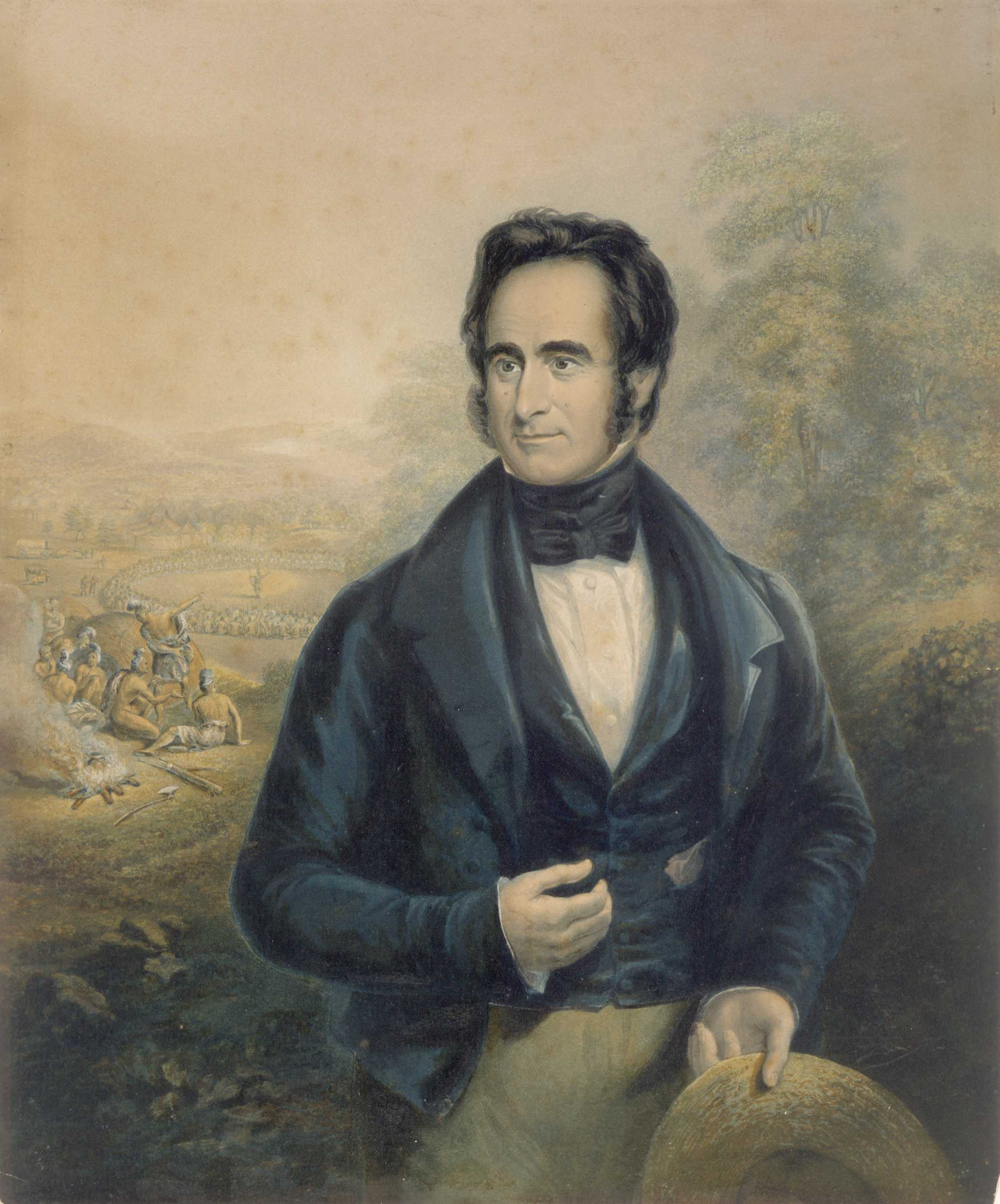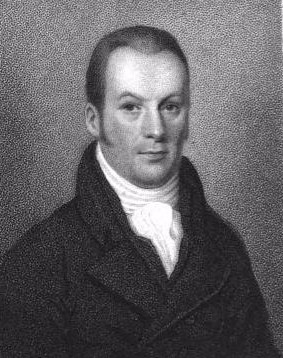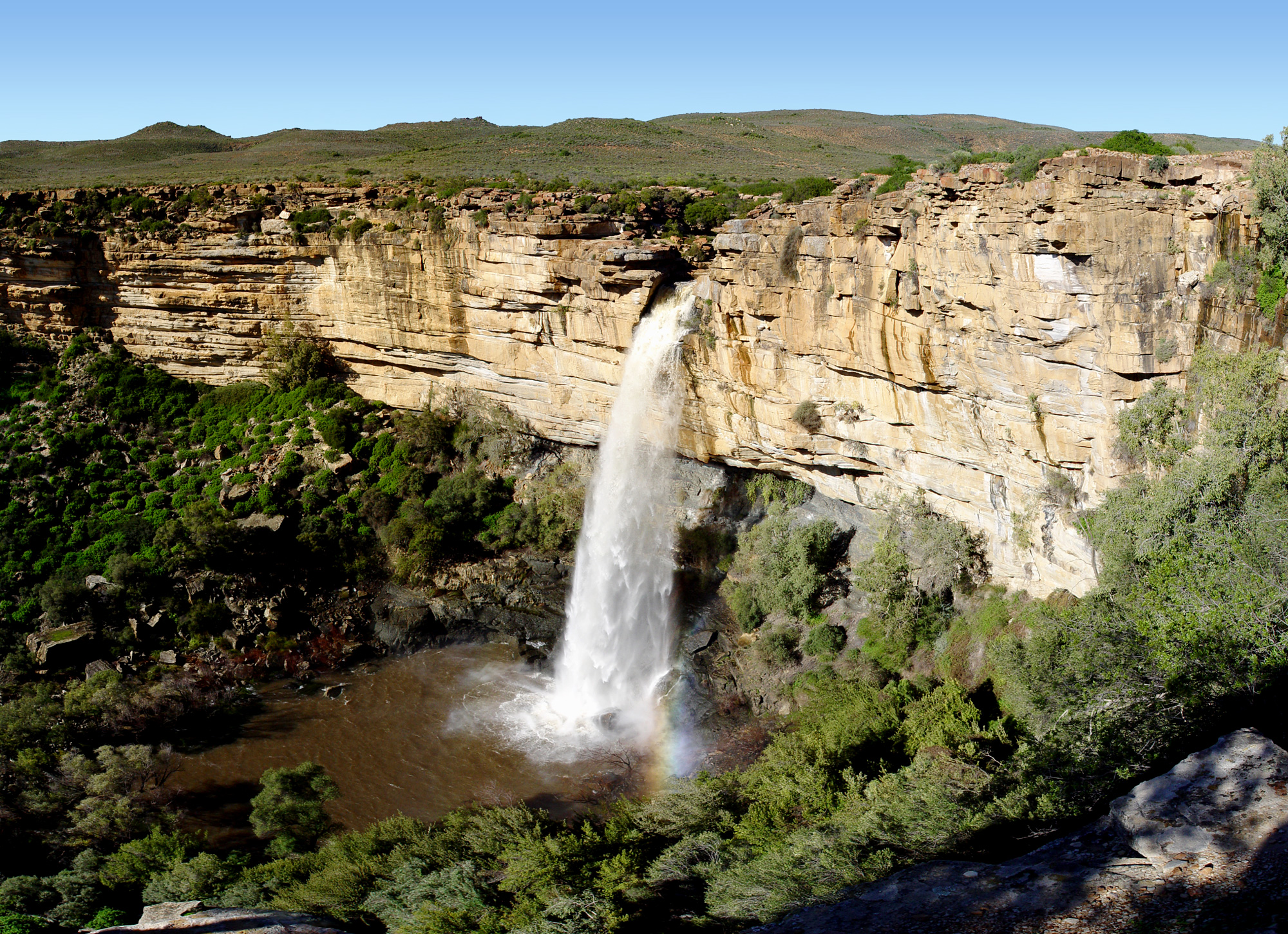|
Robert Moffat (missionary)
Robert Moffat (21 December 1795 – 9 August 1883) was a Scottish Congregationalist missionary to Africa, father of Mary Moffat Livingstone and father-in-law of David Livingstone, and first translator of the Bible into Setswana. Life Moffat was born of humble parentage in Ormiston, East Lothian. To find employment, he moved south to Cheshire in England as a gardener. In 1814, whilst employed at West Hall, High Legh in Cheshire he experienced difficulties with his employer due to his Methodist sympathies. For a short period, after having applied successfully to the London Missionary Society (LMS) to become an overseas missionary, he took an interim post as a farmer, at Plantation Farm in Dukinfield (where he first met Mary his future wife). The job had been found for him by William Roby, who took Moffat under his wing for a year. In September 1816, Moffat was formally commissioned at Surrey Chapel in London as a missionary of LMS (on the same day as John Williams) and was ... [...More Info...] [...Related Items...] OR: [Wikipedia] [Google] [Baidu] |
George Baxter, The Reverend Robert Moffat, 1 April 1843
George may refer to: People * George (given name) * George (surname) * George (singer), American-Canadian singer George Nozuka, known by the mononym George * George Washington, First President of the United States * George W. Bush, 43rd President of the United States * George H. W. Bush, 41st President of the United States * George V, King of Great Britain, Ireland, the British Dominions and Emperor of India from 1910-1936 * George VI, King of Great Britain, Ireland, the British Dominions and Emperor of India from 1936-1952 * Prince George of Wales * George Papagheorghe also known as Jorge / GEØRGE * George, stage name of Giorgio Moroder * George Harrison, an English musician and singer-songwriter Places South Africa * George, Western Cape ** George Airport United States * George, Iowa * George, Missouri * George, Washington * George County, Mississippi * George Air Force Base, a former U.S. Air Force base located in California Characters * George (Peppa Pig), a 2-year-ol ... [...More Info...] [...Related Items...] OR: [Wikipedia] [Google] [Baidu] |
William Roby
William Roby (1766–1830) was an English Congregational minister. Life Born at Haigh, near Wigan, Lancashire on 23 March 1766, he was the half-brother of the poet John Roby; his parents belonged to the Church of England. He was educated at Wigan grammar school, where his father Nehemiah Roby was master, and he himself became classical master at the grammar school of Bretherton, Lancashire. Roby owed a change of religious belief to the preaching of John Johnson. Beginning to preach in villages round Bretherton, Roby resigned his teaching position and entered Trevecca College; but only stayed six weeks. After preaching at Worcester, Reading and Ashby-de-la-Zouch, he became Johnson's assistant at St. Paul's Chapel, Wigan. When Johnson moved on, in 1789, he became sole pastor, ordained in London on 20 September 1789. In 1795 Roby took on the Congregational church in Cannon Street, Manchester. He began with an attendance of 150, which he raised substantially. Benjamin Nightingale ... [...More Info...] [...Related Items...] OR: [Wikipedia] [Google] [Baidu] |
Bible
The Bible (from Koine Greek , , 'the books') is a collection of religious texts or scriptures that are held to be sacred in Christianity, Judaism, Samaritanism, and many other religions. The Bible is an anthologya compilation of texts of a variety of forms originally written in Hebrew, Aramaic, and Koine Greek. These texts include instructions, stories, poetry, and prophecies, among other genres. The collection of materials that are accepted as part of the Bible by a particular religious tradition or community is called a biblical canon. Believers in the Bible generally consider it to be a product of divine inspiration, but the way they understand what that means and interpret the text can vary. The religious texts were compiled by different religious communities into various official collections. The earliest contained the first five books of the Bible. It is called the Torah in Hebrew and the Pentateuch (meaning ''five books'') in Greek; the second oldest part was a coll ... [...More Info...] [...Related Items...] OR: [Wikipedia] [Google] [Baidu] |
Royal Geographical Society
The Royal Geographical Society (with the Institute of British Geographers), often shortened to RGS, is a learned society and professional body for geography based in the United Kingdom. Founded in 1830 for the advancement of geographical sciences, the Society has 16,000 members, with its work reaching the public through publications, research groups and lectures. The Society was founded in 1830 under the name ''Geographical Society of London'' as an institution to promote the 'advancement of geographical science'. It later absorbed the older African Association, which had been founded by Sir Joseph Banks in 1788, as well as the Raleigh Club and the Palestine Association. In 1995 it merged with the Institute of British Geographers, a body for academic geographers, to officially become the Royal Geographical Society ''with IBG''. The society is governed by its Council, which is chaired by the Society's President, according to a set of statutes and standing orders. The members ... [...More Info...] [...Related Items...] OR: [Wikipedia] [Google] [Baidu] |
Northern Ndebele People
The Northern Ndebele people ( nd, amaNdebele) are an offshoot of the Bantu found in Southern Africa. Their three related Ndebele groups in South Africa are divided into (Northern and Southern Ndebele), the Northern Ndebele of South Africa comprise three tribes, namely ndebele of Langa/Laka, ndebele of Ndzundza & Mghumbhane/ mokopone-Mashashani who are ndebele of kekana (Manala) whereas the Southern Ndebele comprise mzilikazi they are a young compared to those of Langa & Ndzundza . This "Northern Ndebele" group from Zimbabwe is not the same as the Northern Ndebele group from South Africa and the two groups are not related either genealogically or historically, however, the Northern Ndebele and Southern Ndebele of South Africa are related genealogically and historically. They speak a language called isiNdebele. The Northern Ndebele were historically referred to as the Matabele by Sotho people, for a Nguni speaking person. Sotho people called all Nguni-speaking people 'Matebe ... [...More Info...] [...Related Items...] OR: [Wikipedia] [Google] [Baidu] |
Tswana People
The Tswana ( tn, Batswana, singular ''Motswana'') are a Bantu-speaking ethnic group native to Southern Africa. The Tswana language is a principal member of the Sotho-Tswana language group. Ethnic Tswana made up approximately 85% of the population of Botswana in 2011. Batswana are the native people of south and eastern Botswana, and the Gauteng, North West, Northern Cape and Free State provinces of South Africa, where the majority of Batswana are located. History Early history of Batswana The Batswana are descended mainly from Bantu-speaking tribes along with the Khoi-San. Tswana tribe migrated southward to Africa around 600 CE, living in tribal enclaves as farmers and herders. Several Iron Age cultures flourished around the 900 CE, including the Toutswemogala Hill Iron Age settlement. The Toutswe were in the eastern region of what is now Botswana, relying on Tswana cattle breed held in kraals as their source of wealth. The arrival of the ancestors of the Tswana-speaker ... [...More Info...] [...Related Items...] OR: [Wikipedia] [Google] [Baidu] |
Vaal River
The Vaal River ( ; Khoemana: ) is the largest tributary of the Orange River in South Africa. The river has its source near Breyten in Mpumalanga province, east of Johannesburg and about north of Ermelo and only about from the Indian Ocean. It then flows westwards to its conjunction with the Orange River southwest of Kimberley in the Northern Cape. It is long, and forms the border between Mpumalanga, Gauteng and North West Province on its north bank, and the Free State on its south. It is the third largest river in South Africa after the Orange River (2200 km long) and the Limpopo River (1750 km long) and was established as the main source of water for the great Witswatersrand area after the gold rush during the 19th century. The Vaal Dam lies on the Vaal River in Deneysville just south of the border between Gauteng and the Free State. It is also important to note that the Vaal River is the longest river wholly within the borders of South Africa. ''Vaal'' is a D ... [...More Info...] [...Related Items...] OR: [Wikipedia] [Google] [Baidu] |
Kuruman Moffat Mission
The Kuruman Moffat Mission at Seodin outside Kuruman, South Africa, traces its establishment, by the London Missionary Society, to 1816, although the first settlement was not where the mission now stands but at ‘New Lattakoo’. The move to the present site at Seodin was made in 1824. Missionaries William Edwards and Robert Hamilton founded the mission but it was Robert Moffat, who joined them in 1820, whose name became synonymous with the Kuruman Mission. He with his wife Mary Moffat remained there until 1870. Having learnt Setswana, Moffat produced a complete translation of the Bible by 1857, in which year it was printed on the mission press at Kuruman - the first time that the Bible had been printed in its entirety anywhere in Africa, and the first time in a previously unwritten African language.Bradlow, F.R. 1987 ''Printing for Africa: the story of Robert Moffat and the Kuruman Press''. Kuruman: Kuruman Moffat Mission Trust. See also * Mary Moffat Mary Moffat born Mary ... [...More Info...] [...Related Items...] OR: [Wikipedia] [Google] [Baidu] |
Mary Livingstone (nee Moffat)
Mary Livingstone (née Moffat; 12 April 1821 – 27 April 1862) was the wife of the Scottish Congregationalist missionary David Livingstone. She was a linguist, an experienced traveller, and managed the household affairs including missionary stations and infant school. Mary was fluent in Tswana, the language of the BaTswana people. Her linguistic abilities and her lived experience of working in remote outposts in Southern Africa made it possible for the couple of survive. Biography Mary Moffat was the first of ten children born to Robert Moffat, a Scottish missionary, and his wife Mary (née Smith 1795–1870). Mary was born in Griquatown, about 93 miles west of Kimberley. She spent her early life at the mission at Kuruman. From 1839 to 1843 she lived in Britain with her parents. Her father, Robert Moffat, was a Scottish Congregationalist missionary who worked among the Bechuana people at Kuruman. [...More Info...] [...Related Items...] OR: [Wikipedia] [Google] [Baidu] |
Griquatown
Griekwastad is a country town in South Africa. It is sometimes still called Griquatown (the meaning of the town's name in Afrikaans), a name which is now considered historical. The town is in the Northern Cape Province of South Africa by road west from the city of Kimberley. It was the first town to be established in the country north of the Orange River. History In 1801 William Anderson and Cornelius Kramer, of the London Missionary Society, established a station among the Griqua at ''Leeuwenkuil''. The site proved too arid for cultivation. In about 1805 they moved the station to another spring further up the valley and called it ''Klaarwater''. Their second choice was little better than their first, and for many years a lack of water prevented any further development. The name of the settlement was changed later to Griquatown or ''Griekwastad'' in Afrikaans. They lived among a mixed nomadic community of the Chaguriqua tribe and "bastaards" (people of mixed origin) from Pike ... [...More Info...] [...Related Items...] OR: [Wikipedia] [Google] [Baidu] |
Namaqualand
Namaqualand (khoekhoe: "Nama-kwa" meaning Nama Khoe people's land) is an arid region of Namibia and South Africa, extending along the west coast over and covering a total area of . It is divided by the lower course of the Orange River into two portions – Little Namaqualand to the south and Great Namaqualand to the north. Little Namaqualand is within the Namakwa District Municipality, forming part of Northern Cape Province, South Africa. It is geographically the largest district in the country, spanning over 26,836 km2. A typical municipality is Kamiesberg Local Municipality. The semidesert Succulent Karoo region experiences hot summers, sparse rainfall, and cold winters.Discover South Africa: Your Online Travel Directory. Discover Namakwa. Great Namaqualand in the Karas Region of Namibia, is sparsely populated by the Namaqua, a Khoikhoi people who have traditionally inhabited the Namaqualand region. Tourism The area’s landscape ranges from an unexploited coast ... [...More Info...] [...Related Items...] OR: [Wikipedia] [Google] [Baidu] |
Cape Town
Cape Town ( af, Kaapstad; , xh, iKapa) is one of South Africa's three capital cities, serving as the seat of the Parliament of South Africa. It is the legislative capital of the country, the oldest city in the country, and the second largest (after Johannesburg). Colloquially named the ''Mother City'', it is the largest city of the Western Cape province, and is managed by the City of Cape Town metropolitan municipality. The other two capitals are Pretoria, the executive capital, located in Gauteng, where the Presidency is based, and Bloemfontein, the judicial capital in the Free State, where the Supreme Court of Appeal is located. Cape Town is ranked as a Beta world city by the Globalization and World Cities Research Network. The city is known for its harbour, for its natural setting in the Cape Floristic Region, and for landmarks such as Table Mountain and Cape Point. Cape Town is home to 66% of the Western Cape's population. In 2014, Cape Town was named the best place ... [...More Info...] [...Related Items...] OR: [Wikipedia] [Google] [Baidu] |


.jpg)


_(14796270283).jpg)



